Schefflera: description, types and care at home
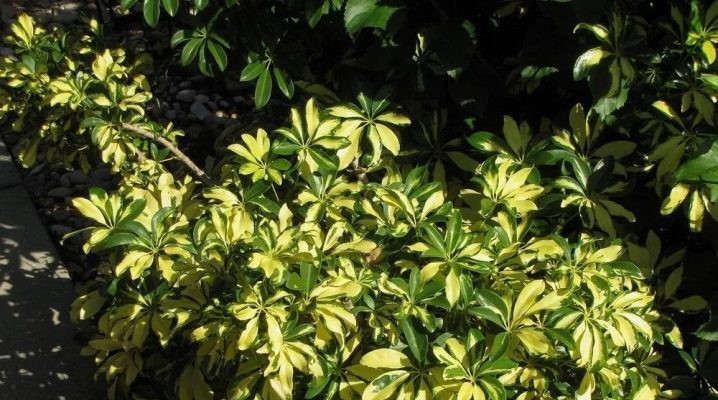
Schefflera has become popular because caring for this plant is so simple that even a novice grower can handle it. In order for this culture to grow healthy and lush, it will be necessary to provide it with the necessary indoor temperature, humidity, water and fertilize it in time.

Peculiarities
Sheffler's indoor flower usually reaches a height of 30 centimeters, but it can be taller if you do not control its growth. It needs enough space around it, since the plant grows a lot in width.
The leaves are arranged on a long stem and look like an umbrella with 8 petals. They are leathery, unevenly green, with a dark shade combined with a light one. This cute houseplant is an evergreen shrub, hence the interest of breeders. They brought the sheffler from Taiwan, where colorful yellow flowers grow in their natural environment.
The leaves of the described plant not only emit oxygen, but also absorb benzene and formaldehyde. Growing this plant is quite easy. This flower is poisonous, but it cannot do much harm to a person.
In order not to face nausea and vomiting, it is better to work with it with gloves, and then wash your hands with soap and water.

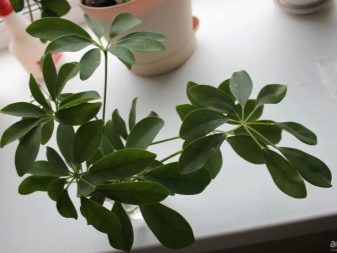
Bloom
The flowering period of the described culture is July-October. Small flowers are formed on the bush, collected in umbrellas, they hang down and very much resemble tentacles from the side. Over time, small spherical stone fruits ripen on the bush. In culture, the bush practically does not bloom.


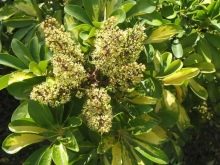
How does heptapleurum differ from a flower?
Novice growers often cannot tell the sheffler from the heptapleurum, because they look very similar in appearance. It is not surprising, because the second plant is a close relative of the shefflera.
Sellers often use this and give out one flower after another. In fact, there are differences between them, although they are not so significant. It must always be remembered that the shefflera is grown exclusively in tree form. If the grower removes the growth point, then the flower dies.
If you need to determine quickly when buying, whether the plant is young in front of you, then you should lightly rub its leaves with your fingers. In the heptapleurum, they exude an aroma that is very similar to that of geranium.


Varieties
All sheffler varieties are divided by type.
- Radiant. This is the most common form of the plant. The tree is growing rapidly, with a maximum height of 3 meters. Each umbrella has 16 oblong leaves, the color can be either bright green or light.


- Fingered. This variety is loved for its small height and compactness. The foliage is cut into several lobes, the ends are sharp. The shade can be uniform or not. It can be distinguished by its prominent veins and wavy edge.

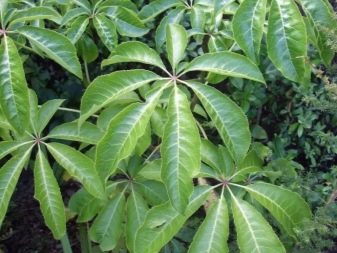
- Star-leaved... It has reddish-brown shoots and glossy foliage that can be an attractive olive shade, golden or deep green, depending on the variety chosen.


- Tree-like, or sheffler arboricola. It grows low, rarely taller than 1 meter. The branches grow stiff over time, the trunk is straight. Pruning well can produce an attractive tree with rich green leaves. This species is prized by breeders for its resistance to fungal diseases and insects.

- Variegated. It is also a tree-like shape, characterized by dark green foliage with spots that can be cream or yellow. It is not common to see the described species on window sills, but it has an amazing decorative shape.


- Octal-leafed. A rare flower with foliage of a delicate olive shade with prominent veins. The front surface of the leaves is glossy, the inside is matte.
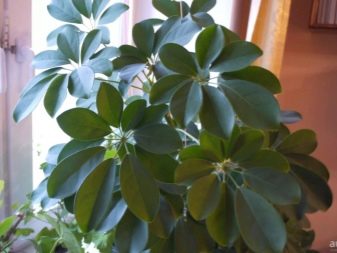

- Louisiana. This is one of the most beautiful shefflera species, as it has amazingly beautiful foliage. Its shade is very juicy, saturated, it has light green spots.

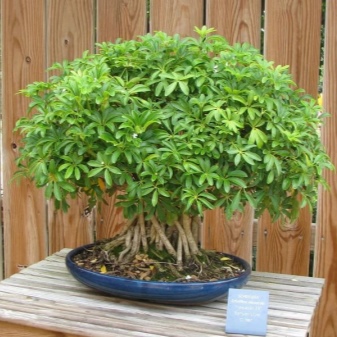
As for the varieties, on the windowsills of experienced and novice growers you can most often find such.
- Bianca. Popular for its unusual foliage pattern. It blooms only in a greenhouse under certain conditions. The sheffler can grow up to 2.5 meters in height, while in the natural environment the bush sometimes reaches 20 meters.


- Janine. Its distinctive features are small foliage, the color of which from the side is similar to the blurry colors of the green palette. Leaves are feathery along the edge.

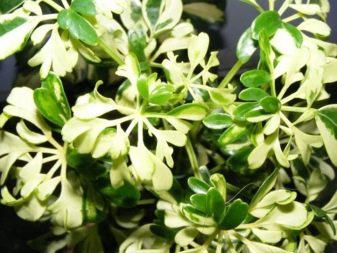
- "Nora". The leaves are light green, not large, they look very elegant. Growers love the presented variety with jagged edges and small splashes of yellow. With proper pruning, the crown turns out to be lush.


- Gerda. A tree-like variety with luxurious foliage of a yellow-green or just green hue.


- Melanie. It does not require much space, since it cannot grow very wide. The variety was loved precisely for its compact size.


- "Gold Capella"... The variegated form, in which the trunk is erect, from the side may resemble a palm tree. The maximum height in culture is 120 cm.


- Amate. An elegant variety with glossy foliage. It attracts the attention of breeders due to its resistance to diseases and insects. Feels great in the shade, unlike many other shefflera varieties.

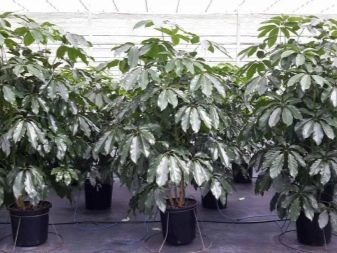
Conditions of detention
If you follow the conditions for growing a plant, then it will grow beautiful, bright. The best place to grow in the house is a sunny windowsill, but behind a curtain. In summer, a little shading can be helpful.
Exposure to direct sunlight causes burns to foliage. On warm days, the sheffler is allowed to take it outside.
Temperature and humidity
Temperatures between 15 and 20 degrees are ideal for the described plant. However, indoors, it should not drop to +12 and below, as this will lead to loss of leaves. For even and straight growth, the plant must always face the light. Otherwise, the color of the leaves on the side that is turned away from the light can become discolored or even go bald. From time to time, the flower is recommended to be turned, so the entire crown will receive the required amount of heat and sunlight.
Although the Schefflera loves moisture, she is quite tolerant of dry air.
This flower is more resistant to lack of moisture than most houseplants, but it is still better to install an automatic humidifier or place a container of water and small stones next to it.


Lighting
The described plant needs bright, but indirect light, that is, the sun's rays should not fall on its foliage. Sometimes breeders notice that the flower has become sprawling, all the shoots are very elongated, no longer stand straight, but hang down. The reason for this is that Sheffler simply does not have enough light, so she reaches for him.
The easiest way to fix the problem is to move the plant to the south window or place artificial light lamps in the room at a distance of 20 centimeters from the foliage.


How to care?
Caring for an indoor flower at home is unremarkable and does not differ from that which should be provided to any plant in the house.In winter, you should think about a transplant, reduce the amount of watering, remove the pot from the windowsill, away from cold drafts.
It is worth especially responsibly to treat the type of soil used. The best solution is to mix the substrate. It is desirable that it consists of from 4 parts of clay, 2-3 parts of soil, 1 part of lavalite, granules of lava or pumice gravel and 0.5 part of quartz sand.
The pH value should be between 6.0-6.5. It can be adjusted by adding clay. Sheffler can also be kept hydroponically.


Watering
When growing shefflers, it should be borne in mind that proper watering will help keep the houseplant healthy. Each time you need to wait until the soil in the pot is dry enough, only then add a new portion of water.
Yellow leaves that fall off the plant are a sign that watering may be too frequent. This flower needs a well-drained soil that does not become swampy, otherwise stem and root rot will appear on it.
Drainage must be organized in the pot. In summer, when the air temperature is higher, the plant is watered once a week, in winter - only once every few weeks.


This plant does not like too dry or wet soil. Experienced growers are advised to consider the following points:
- from April to September, water the land in moderation;
- before each moistening, the top layer of the substrate must dry to a depth of 2 cm;
- water the pot until water runs out of the drainage holes;
- water from the pan under the pot is removed after it has completely drained;
- avoid waterlogging of the air in the room;
- too dry a substrate causes the appearance of brown dried leaves;
- too wet substrate causes rotting and loss of foliage;
- spray moisture using a spray gun or automatic installations if the air in the room is too dry;
- indoor humidity should be at the level of 60-70%;
- warm water is used for spraying and watering; it is desirable that it be several degrees warmer than room temperature;
- to maintain the shine of the leaves, you need to wipe them with a damp cloth from time to time.


Top dressing
Water-soluble dressing helps to support the flower during the period of active growth, which is applied once a month along with watering. To provide the sheffler with the necessary nutrients, it needs to be fertilized from spring to autumn. The proportion should be four times less than indicated on the package. If a dry mixture is applied to the ground, then before that it is watered. This is a prerequisite, otherwise the roots will simply burn out.
In winter, during the dormant period and after transplantation, the plant is not fertilized.

Pruning
It is necessary to prune the flower from time to time, especially if it is not getting enough light. This procedure is simple - you need to cut off what seems superfluous and out of shape. The flower looks better and more luxuriant when several plants are placed in one pot. The best time to cut the shoots is spring, no later than May. There are some general rules for pruning:
- long shoots can be shortened by 2/3;
- easy pruning of the tips of the shoots contributes to the growth of new side branches;
- the cut is always done over the kidneys;
- joints on the trunk form numerous new shoots;
- cut off old inflorescences, if any;
- sick and damaged parts are regularly removed.
The remaining cuttings can be used to grow new flowers.


Transfer
From time to time, the sheffler needs to be transplanted. On average, this procedure is performed every 2-3 years. It's time to change the pot when the roots start to stick out from the top of the soil or from the drainage holes.
The best time to transplant is early spring. First, carefully remove the plant from the pot. If it does not give in, it is worth lightly watering the soil and walking with a sharp knife along the edge of the container.After carefully remove the old substrate from the roots, inspect for the presence of old, damaged, rotten roots, which will need to be removed at this stage. You can carry out a preventive treatment with a fungicide.
The tool used must be disinfected with a 10% bleach solution or wiped with alcohol.

The new pot should only be slightly larger than the old one, on average 5 cm in diameter. Drainage is organized from small pebbles or brick chips at the bottom of the tank, it is he who will ensure the removal of excessive water during irrigation. On top of this layer, the prepared substrate is poured to the middle, the flower is set, the rest of the soil is added, then it is lightly pressed on the soil, then watered.
Step by step, this process can be represented as follows.
- Before transplanting, in a few days, you need to make high-quality watering of the plant, and in a few weeks you need to fertilize so that the flower gains strength and does not experience a strong shock.
- First, you need to prune dead and diseased stems, which are often the cause of bacterial and fungal diseases. If the crown is too large and you want to make it more compact, you can remove the extra shoots. Cut the stems in half to stimulate new growth.
- Take the sheffler out of the container by turning it upside down, but holding the bush by the trunk at the base of the soil.
- Remove dead or rotten roots with sharp pruning shears or scissors. The smoother the cut, the better the wound will heal. You can treat it with a solution of activated carbon.
- In an already prepared new pot with drainage and the first part of the soil, the sheffler is placed in the center so that the root ball is located at the level of the edges of the container.

Some inexperienced growers do not understand why fertilizers cannot be applied after transplanting, because they help the flower to gain growth and green mass faster. This is precisely the main problem, since after pruning, the roots need to develop a full-fledged system again, otherwise they simply will not cope with providing a large plant with the necessary minerals and water.
A small root system will not be able to feed a rapidly growing plant, and as a result it will become sore and eventually die. That is why you need to give the flower the opportunity to root well at first, only after that can we talk about feeding.
Reproduction
There are several ways how a sheffler can be propagated:
- apical cuttings (green stems);
- air layering;
- seeds.
Reproduction of this indoor plant can be carried out using terminal, leaf or stem cuttings, as well as seeds. Propagation by cuttings usually produces a new flower faster.
When planting seeds, it can take several months for the seedlings to emerge from the nutrient medium.

There are special requirements for the processes, as well as for the reproduction process in general:
- cuttings are cut from January to March or at the end of summer;
- rooting occurs fairly quickly under ideal conditions;
- stem cuttings are cut from the middle of the stem axis, they should be about 10-20 cm long;
- leaves in the lower part are removed, only 3 or 4 remain on the shoot;
- stem cuttings are cut right under the knot;
- rooting can be done in a glass of soft water;
- the substrate must be kept evenly moist;
- in case of rooting in a glass of water, it is worth adding a little ash there to prevent rotting;
- rooting takes 4-12 weeks depending on ambient temperature and light;
- use only healthy and strong shoots of the mother plant;
- take a sharp knife to cut a thin strip at the lowest end of the stem, then place the shoot about 1 cm deep in a small pot filled with soil rich in sphagnum moss;
- the pot at the germination stage should be covered with polyethylene, but it will be necessary to remove the film every day for some time to ensure high-quality ventilation;
- rooting occurs after about 3 months.

You can germinate the culture in water. As soon as the cuttings take root in a glass, they can be planted in the ground. When they are about 3 to 5 cm tall, they can be moved into a container where the plant will live for the first few years. Growing in pots is generally preferred as the small roots are very sensitive and can be damaged during planting.
Between February and March or July, you can sow seeds in a wide bowl or a closed greenhouse using ordinary soil or compost. The substrate must be kept evenly moist until shoots appear. Soil temperature is about 25 degrees.
When the seedlings are large and strong enough, they can be taken with a small spatula from the soil and transplanted into pots.
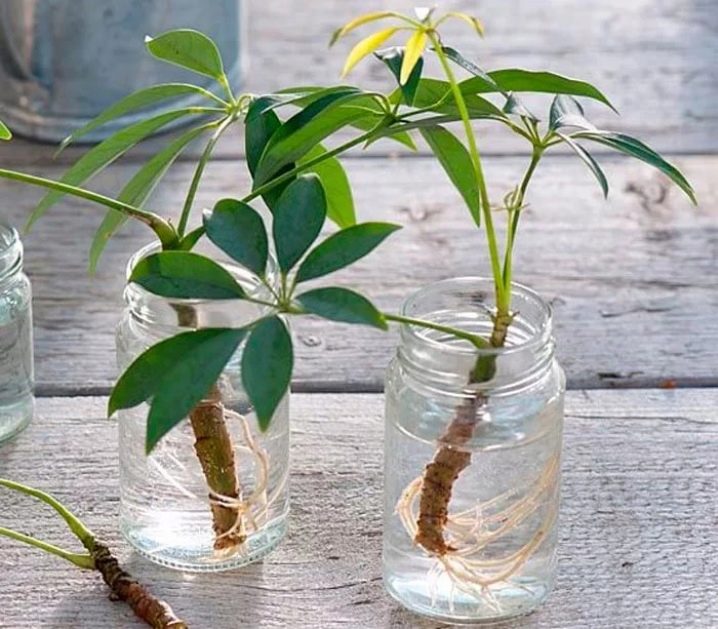
Diseases and pests
The sheffler plant does not often suffer from pests or diseases. In most cases, the appearance of aphids, mealy bugs or other insects is the result of unfavorable growing conditions. Scaly pests are recognizable by their small brown bodies and sticky dew on foliage.
Aphid attacks can be eliminated with a simple warm shower. Almost all insects do not like an increase in moisture, and one such procedure is enough to cope with the problem.
Spider mites and mealy mites are the most common insects that infest the plant. For mild infections, simply washing the foliage and stem with water and soap will help. Insecticides and neem oil can help with the more severe form.


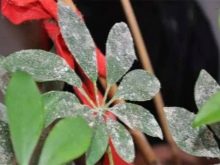
Although shefflera is not prone to disease, she can contract root rot. It is a fungal disease that is fueled by too much moisture. In the worst case, damage can lead to the death of the plant. Signs of root rot are yellow leaves, an unpleasant odor from the substrate, and black roots and shoots.
If the grower detects root rot, he must react immediately. The flower is removed from the pot, all soil, rotten roots and plant parts are removed. Then the roots are treated with a fungicide and transplanted to the sheffler in a new pot and soil.

Other fungal infections appear as large, waterlogged brown or black spots with a yellow halo. They can spread over the leaves in a few days. If a plant is grown from seeds or a small seedling is bought, at first it is worth keeping them in quarantine. Numerous pathogens are responsible for fungal diseases. Phytophthora infects the lower leaves, then moves upward.
Almost all fungal infections are eliminated by modern fungicides, as for bacterial lesions - they cannot be cured, but at an early stage, the plant can be saved if all damaged shoots are removed. After processing, the flower is moved to the quarantine zone and they just wait - it will either recover or die.
Bacterial contamination can be identified by the appearance of small watery spots on the edge of the leaves. If nothing is done, they begin to quickly combine, turn black and lead to a strong leaf fall. The entire plant is affected. Yellowish dotted spots may grow between leaf veins.

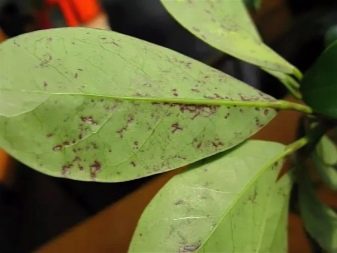
Because wet leaves allow fungal spores to germinate, the breeder must keep the plant's foliage dry. This is one of the reasons why you should not humidify the air near the shefflers or do overhead watering. They always remove healthy plants from sick ones, remove leaves if the crown density is too high and air does not penetrate inside. It is also necessary to provide enough space between the bushes for better air circulation.
Small brown spots spreading from the outside of the leaves down to the stems are a fungal infection that is quite aggressive. The first symptoms appear within two days after infection. The lesions may be just brown or have a yellow halo.
Fungal ulcers begin to spread from the base of the plant and travel upward. They often attack the sheffler when she is under stress, such as after a transplant.

It is usually too late to save the flower after the grower has noticed the symptoms. If there is a suspicion that after the transplant the sheffler has weakened or the roots have been damaged, preventive treatment will help save the flower.
Disease prevention can eliminate many problems in the future. Many fungicides and bactericides are available in specialized stores, but remember that shefflera is sensitive to chemical damage.
Bacterial and fungal infections quickly spread on wet leaf surfaces, so experienced growers never stop reminding that dry leaves completely prevent the occurrence of many diseases.
Timely application of top dressing forms a good immunity in the flower, so that the shefflera can cope with infection.
How to properly care for a shefflera, see below.



























The comment was sent successfully.